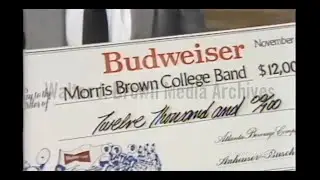Georgia State Troopers Issued Pontiac Firebird Trans Am Vehicles (July 1, 1982)
Voiceover: the Georgia State Patrol will have three new Trans Ams on the road over the holiday weekend as part of a six-month pilot program. Footage of a state trooper getting into a current patrol car, and then footage of the new silver Trans Am patrol car. Footage from inside the new car while an unknown trooper is driving on the interstate, and telling the reporter that the new vehicle can travel at higher speeds and maneuvers well, followed by an unidentified State Patrol spokesperson stating that they will be assigning the new cars to veteran pursuit drivers and will be geographically located all over the state. Footage of the reporter sitting in the driver’s seat of a new patrol car and wrapping up the story.
The Pontiac Firebird is an American automobile that was built and produced by Pontiac from the 1967 to 2002 model years.[1] Designed as a pony car to compete with the Ford Mustang, it was introduced on February 23, 1967, five months after GM's Chevrolet division's platform-sharing Camaro.[2] This also coincided with the release of the 1967 Mercury Cougar, Ford's upscale, platform-sharing version of the Mustang.[3][4]
The name "Firebird" was also previously used by GM for the General Motors Firebird in the 1950s and early 1960s concept cars.[5]
The third generation Pontiac Firebird was introduced in late 1981 by Pontiac alongside its corporate cousin, the Chevrolet Camaro for the 1982 model year. These were also the first Firebirds with factory fuel injection, four-speed automatic transmissions, five-speed manual transmissions, four-cylinder engines, 16-inch wheels, and hatchback bodies.[3]
The third generation of Firebirds consisted of three models: Firebird, Firebird S/E, and Firebird Trans Am. The Firebird was the base model, equivalent to the Camaro Sport Coupe; the Firebird S/E was the luxury version; and the Trans Am, the high-performance version. For 1982, the new Firebird had been completely restyled, with the windshield slope set at a dramatic, more aerodynamic 62 degrees,[4] (about 3 degrees steeper than anything GM had ever tried before), flush-mounted side glass, and for the first time, a large, glass-dominated rear hatchback. Electronically controlled retractable headlamps, and a rounded hoodline and front fenders were the primary characteristics that distinguished the Firebird from its Camaro sibling and its previous Firebird incarnations. The Firebird would retain hidden headlamps until the end of all production in 2002. Pontiac had also hoped to drop the "Trans Am" moniker from the redesigned cars to save royalties paid to the SCCA for use of the name. Early promotional cars were marked "T/A" as an alternative, however it was decided that doing so might cause more problems than it was worth and the "Trans Am" nameplate remained. Still, with its dimensions reduced, wheelbase shortened, and weight reduced, the third generation Firebird was also the closest yet in size to the original 1967 model. It won "Best Sports GT" category in the $11,000 to $14,000 range (also along with the Camaro). Road & Track called the fuel-injected Trans Am "a dramatic improvement on its predecessors," accelerating from 0–60 in 9.2 seconds.[5]
The new Firebird shrank to a 101-inch wheelbase, losing more than 8 inches in overall length, measured about an inch narrower, and weighed nearly 500 lb (227 kg) less than its 1981 predecessor. It also was the most aerodynamic production Firebird to date with a drag coefficient of 0.33. The new Trans Am took things a bit further, with a coefficient of .32.[6] The Trans Am body would continue to improve aerodynamically over the years, and by 1985 would be the most aerodynamic vehicle to ever be released from General Motors with a 0.29 coefficient of drag. Wind tunnels were used to form the third generation F-Body's shape, and these aerodynamic developments were fully taken advantage of by Pontiac's design team. The sleek new car had a low slung front end which featured split grilles. They fed some air to the radiator but most of the air came from an air dam underneath the front bumper. Every piece of the car was designed to reduce drag.































